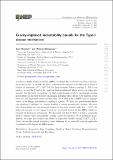Gravity-improved metastability bounds for the Type-I seesaw mechanism
Author(s)
Chauhan, Garv; Steingasser, Thomas
Download13130_2023_Article_21831.pdf (2.970Mb)
Publisher with Creative Commons License
Publisher with Creative Commons License
Creative Commons Attribution
Terms of use
Metadata
Show full item recordAbstract
Abstract
Right-handed neutrinos (RHN) destabilize the electroweak vacuum by increasing its decay rate. In the SM, the latter is dominated by physics at the RG scale at which λ reaches its minimum,
μ
∗
SM
$$ {\mu}_{\ast}^{\textrm{SM}} $$
∼ 1017 GeV. For large neutrino Yukawa coupling Yν, RHNs can push μ* beyond the Planck scale, implying that gravitational effects need to be taken into account. In this work, we perform the first comprehensive study of electroweak vacuum metastability in the type-I seesaw mechanism including these effects. Our analysis covers both low- and high-scale seesaw models, with two as well as three RHNs and for multiple values of the Higgs’ non-minimal coupling to gravity. We find that gravitational effects can significantly stabilize the vacuum, leading to weaker metastability bounds. We show that metastability sets the strongest bounds for low-scale seesaws with MN > 1 TeV. For high-scale seesaws, we find upper bounds on the allowed masses for the RHNs, which are relevant for high-scale leptogenesis. We also point out that Tr(
Y
ν
†
$$ {Y}_{\nu}^{\dagger } $$
Yν), which is commonly used to express these metastability bounds, cannot be used for all of parameter space. Instead, we argue that bounds can always be expressed reliably through Tr(
Y
ν
†
$$ {Y}_{\nu}^{\dagger } $$
Yν
Y
ν
†
$$ {Y}_{\nu}^{\dagger } $$
Yν). Lastly, we use this insight to develop a new technique for an easier RG analysis applicable to scenarios with degenerate RHN masses.
Date issued
2023-09-22Department
Massachusetts Institute of Technology. Department of PhysicsPublisher
Springer Berlin Heidelberg
Citation
Journal of High Energy Physics. 2023 Sep 22;2023(9):151
Version: Final published version